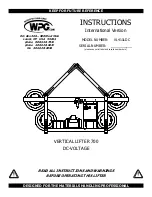
Rev 19.3/9-18
10
VL411LDC: #35162
In order to be considered clearly audible,
the alarm volume must exceed ambient noise by
at least 15 dBA at the operator position.
3
Since the Maximum Alarm Volume is 103 dBA,
ambient noise must not exceed 88 dBA under any circumstances. Furthermore, if ambient noise
measures 88 dBA, the alarm volume must be set to maximum and the operator must remain
within 2 ft [60 cm] of the warning buzzer, in order for it to be effective.
T
O
A
PPLY THE
P
ADS TO A
L
OAD
Positioning the Lifter on the Load
Make certain that the contact surfaces of the load and all vacuum pads are free of any
contaminates that could prevent the pads from sealing against the load (see MAINTENANCE:
V
ACUUM
P
AD
M
AINTENANCE
).
The lifter must be attached only to vertically oriented loads. Center the pad frame from left to
right on the load, and position the uppermost pads near the top edge. This position maximizes
stability while lifting the load. Make sure that all vacuum pads will fit entirely on the load’s
contact surface (see SPECIFICATIONS: Pad Spread) and that they will be loaded evenly while
lifting (see SPECIFICATIONS: Per-Pad Load Capacity). Then apply the lifter to the load so that
all pads are touching the contact surface.
Sealing the Pads against the Load
Firm pressure at the center of the lifter
helps the vacuum pads begin to seal
against the load. Pull the valve handle
outward until it latches securely in the
“apply” ( ) position (power on), as
shown. This energizes the vacuum
pump, causing air to be drawn at the
pads immediately. The red low
vacuum warning light also turns on and remains illuminated until the lifter attains sufficient
vacuum to lift the maximum load weight (see T
O
L
IFT AND
M
OVE THE
L
OAD
: Load Capacity and the
Warning Light to follow). The valve handle must remain in the “apply” ( ) position throughout
the entire lift.
WARNING: Keep valve handle latched securely in “APPLY” position throughout
lift.
Note: If a vacuum pad has been lying against a hard object (as during shipping), it may be
slightly distorted. Although initially it may be difficult to apply the pad to a load, this condition
should correct itself with continued use.
3
Consult CE Standard EN 457 for alternative ways to determine whether the alarm is clearly audible to operators.
TO APPLY
Summary of Contents for VL411LDC
Page 2: ......
Page 30: ...Rev 19 3 9 18 28 VL411LDC 35162...
Page 31: ...Rev 19 3 9 18 29 VL411LDC 35162...
Page 32: ...Rev 19 3 9 18 30 VL411LDC 35162...













































